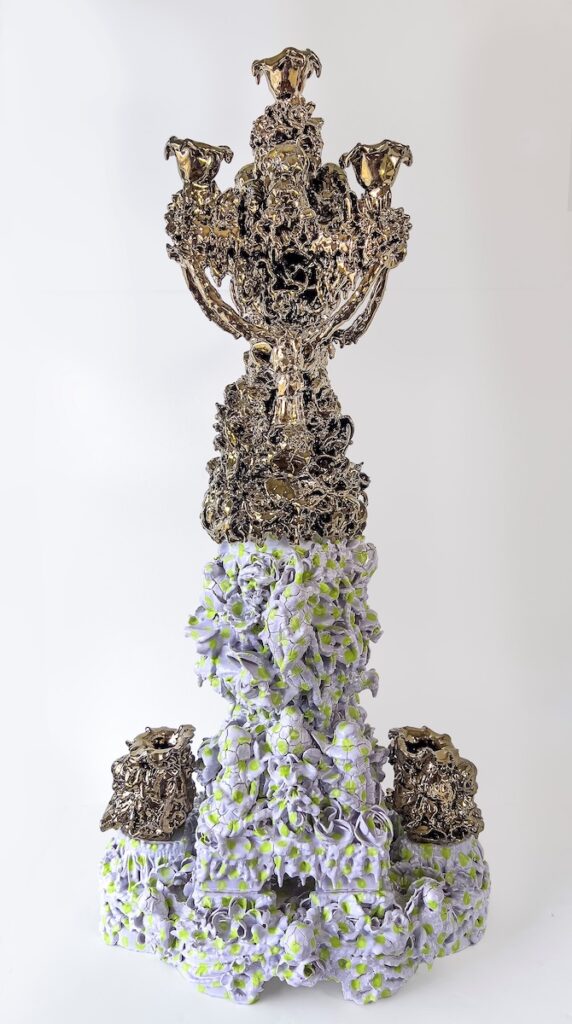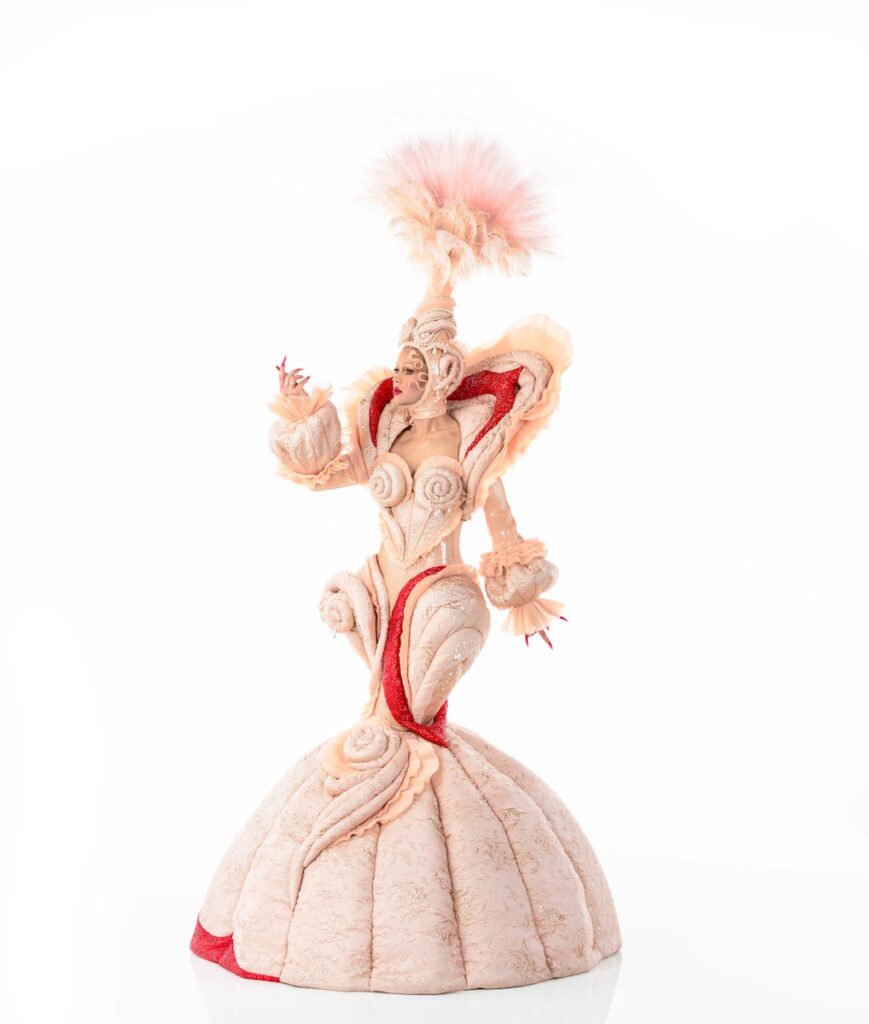Robert Horvath’s Room for the Lost Paradise forms part of a larger exhibition at the Indianapolis Museum of Art titled Resplendent Dreams: Reawakening the Rococo, which showcases the work of three contemporary queer artists who take inspiration from early 18th-century European art. Also featured is Arkansas-based multidisciplinary artist Anthony Sonnenberg, who has contributed three large-scale ceramic sculptures, a garment incorporating found objects and brass jewelry, and a new video work referencing André Leon Talley and Divine (Fig. 1). The third artist is fashion and costume designer Diego Montoya, who creates handmade, one-of-a-kind garments for drag queens and other performers. Five of Diego’s ensembles are on display alongside a newly commissioned gown for the exhibition. Titled Rocaille, it is the IMA’s first-ever commission for the collection of fashion and textiles (Fig. 2).

The exhibition also contains ten 18th-century works from the museum’s permanent collection that were selected by the artists. Anthony chose a landscape painting by François Boucher and a portrait of the actor Charles-François Racot de Grandval by Nicolas Lancret. Diego selected a painting by Jean-Honoré Fragonard, The Joys of Motherhood, which he connected to his and other queer people’s common first experience of seeing the possibilities of fashion and drag in their mothers’ clothes. Robert picked seven porcelain figurines from Meissen and Chelsea, which are playfully reimagined as watercolor paintings in Room for the Lost Paradise.

Robert’s room was the initial seed for this exhibition concept, and the project went through a very long ideation process going back to 2019 with the museum’s Associate Curator of Gallery Teaching, Dr. Kjell Wangensteen. At various points, we had the idea of presenting the porcelain objects and the room itself as a previously unknown and recently unearthed collection from an imaginary, deceased collector with queer predilections.
In the finished piece, there is not a single narrative or supposed collector that ties the room together. The elements of a lost or hidden queer history are still there, but are now sharing space with several other interpretive frameworks that call attention to the material realities of such a lavish room. The work touches on issues of resources and ecological destruction (including the use of AI), labor and authorship, globalism and imperialism. Meredith Martin and Chad Alligood underscore these interpretive possibilities in their responses to the work.
It was refreshing to hear the perspectives of the scholars at the symposium hosted by the IU Indianapolis Arts & Humanities Institute, who had not been immersed in the work’s creation from the beginning and were encountering it for the first time. Makoto Takao, a musicologist whose research focuses on early music and period instruments, provides a sensorial interpretation of the room’s acoustics and imagines the kind of music that might have been played in such a space.
Looking at the other artists in the exhibition, Anthony’s work hones in on the use of decoration and ornament in the Rococo period and its attendant suggestions of frivolity, excess, or queerness. His practice is particularly focused on ceramics, which Robert also loves and has experimented with in his own work.
This exhibition is installed in the museum’s Paul Galleries, which showcase fashion and textiles. The fashion component of the exhibition space is what led me to Diego’s work, which I knew from television and social media. Exhibiting fashion and other media together is something I have always wanted to try as a curator and is not frequently seen in museums, which tend to keep these types of objects separate. When fashion and art pairings arise, it is often because a designer collaborates with an artist, or because there are specific art historical references in a garment.
I was interested in finding correspondences between fashion and visual art that go beyond direct references or artist/designer collaborations. In the case of Resplendent Dreams, what links all three artists is the incredible level of handwork and labor that goes into what are, at their core, luxury objects. All three artists work with studios of assistants, and all of them employ processes of artmaking (hand sewing, handmade ceramics, hand painted parquet and marquetry) that are largely anachronistic and extremely expensive due to the enormous amount of human labor they require. On our symposium tour of the exhibition in progress, IMA conservators Mandie Holden and Allison Slenker underscored the technical virtuosity of the artists—Anthony dipping silk flowers in clay slip and firing them individually in the kiln, or Diego and Ricky applying individual pearl accents onto the surface of the Rocaille gown with tweezers. At the same time, the artists are attuned to contemporary perceptions of the rococo as vulgar or “too much,” and play on its suggestions of decadence and attendant decay. Jason Kelly touches on this element of the room in his response.
In an article surveying several recent museum exhibitions that combine contemporary and historical artworks, ARTnews editor Alex Greenberger asks the question, “what do we want from art history?” This exhibition is one response to that question, but it suggests multiple possible answers. As always, the past is a source of inspiration and reference, but for these artists it is also a mode of escape into subjects, themes, and ideas that are not necessarily valued in the contemporary moment. By bringing out the latent queerness of the rococo, Robert, Anthony, and Diego establish a creative kinship and shared sensibility across centuries, even if the artists of that earlier period did not necessarily understand their work as effeminate or queer. Finally, in a nod to José Esteban Muñoz’s concept of queer futurity, these reworkings of historical styles also function as a joyful or aspirational vision of the future, one in which queer histories are no longer hidden or relegated to the margins but can be freely expressed.
In the spirit of Warhol’s famous statement that Pop Art is about “liking things,” this queer rediscovery of the eighteenth century is animated by a sense of joy and delight in mining areas of the art historical canon that have frequently been belittled or dismissed. Robert, Anthony, and Diego each exhibit an exuberant refusal to conform to normative tastes and desires in their work, a spirit of reclamation that is fundamentally queer in its love of the marginal and the unusual.
Michael Vetter is Associate Curator of Contemporary Art at the Indianapolis Museum of Art at Newfields
Cite this note as: Michael Vetter, “Curator’s Notes: Resplendent Dreams: Reawakening the Rococo” Journal18 (July 2025), https://www.journal18.org/7922.
License: CC BY-NC
Journal18 is published under a Creative Commons CC BY-NC International 4.0 license. Use of any content published in Journal18 must be for non-commercial purposes and appropriate credit must be given to the author of the content. Details for appropriate citation appear above.
